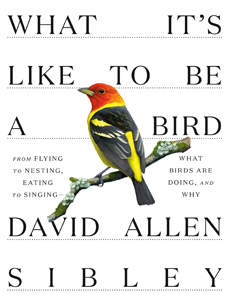 David Allen Sibley, What It’s Like to Be a Bird: From Flying to Nesting, Eating to Singing—What Birds Are Doing, and Why (New York: Knopf, 2020), 203pp.
David Allen Sibley, What It’s Like to Be a Bird: From Flying to Nesting, Eating to Singing—What Birds Are Doing, and Why (New York: Knopf, 2020), 203pp.
A review by Brad Keister, former Deputy Division Director of the Physics Division for the National Science Foundation.
David Allen Sibley is an American ornithologist (as was his father) and illustrator who has published several important field guides for bird identification. He wrote this book to help readers to learn more about various aspects of birds that are normally thought to be reserved for humans.
Indeed, different birds have abilities that easily outstrip our own. These include almost 360-degree vision, the ability to dive at over 200 miles per hour, extra balance centers so that they can even sleep on one leg, and the ability to fly thousands of miles, navigating by the stars alone. After a brief introduction, Sibley features 96 species of his choice to illustrate the breadth of ways that birds live in our world. Each is worth reading about even if you don’t expect ever to see some of them.
The New York Times recently asked 22 writers each to suggest a book for incoming President Joe Biden’s reading list. Among them was Karla Cornejo Villavicencio, the author of The Undocumented Americans, who had this to say about Sibley's book: “I focus on a few birds every night before I go to bed. Look at the birds that are hated, forcibly sterilized, shot with rifles because they are big and dark and scavenge to survive. Learn what makes them beautiful and ask why God created them. You represent them, too, not just the garden songbirds.”
That said, even the most-admired songbirds have a hard existence: most do not live more than two years, the mortality rate of young birds is very high, even without human intervention. Sibley’s book challenges us to stop and appreciate just a small segment of the created world, which comes at great cost to its inhabitants.
Dan Clendenin: dan@journeywithjesus.net


